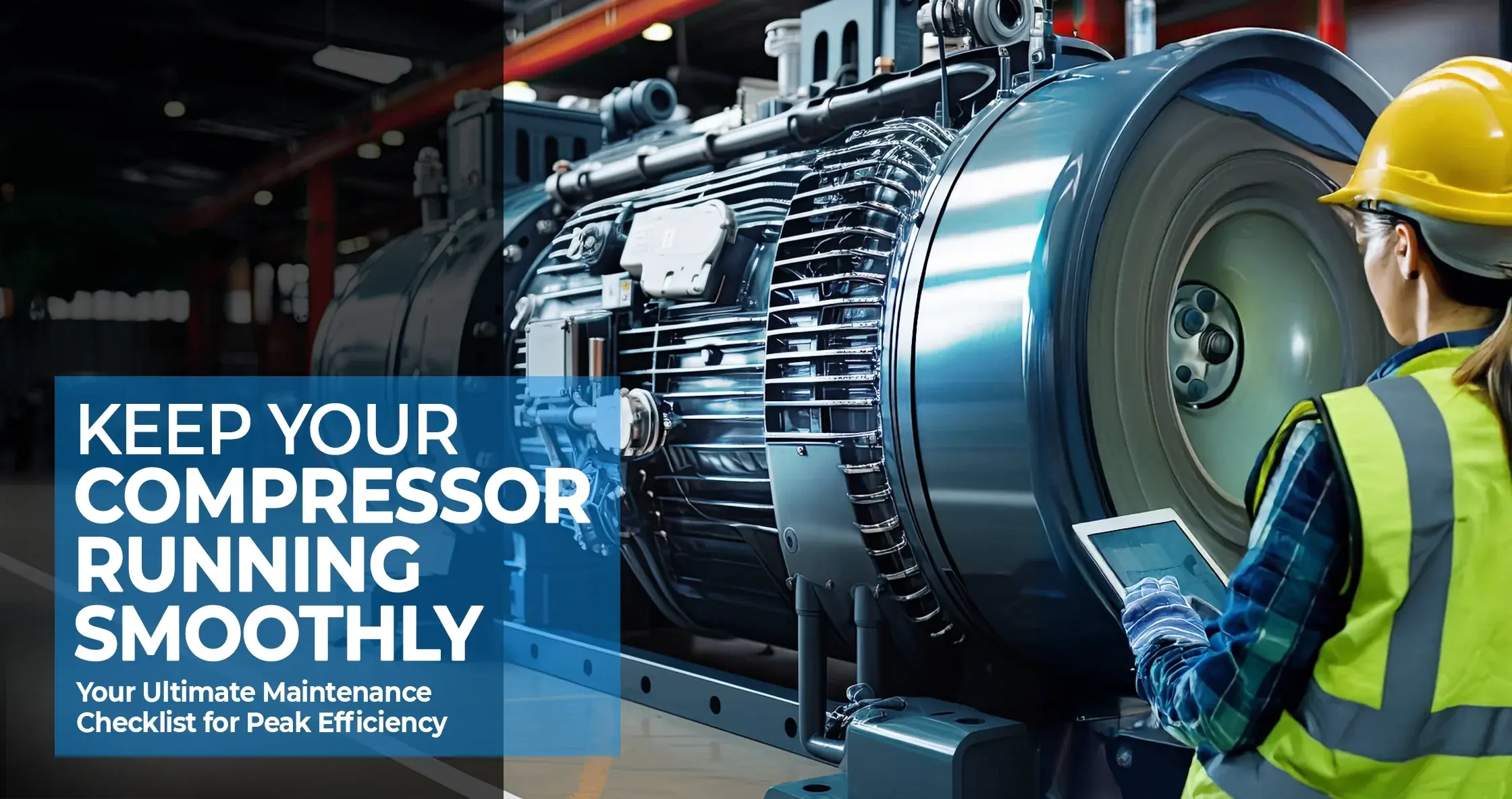Compressed air is one of the most critical utilities in industrial, commercial, and even DIY environments. But to keep your system performing at its best, regular compressor maintenance is non-negotiable. Without consistent upkeep, performance degrades, energy consumption increases, and the risk of system failure rises significantly. In this guide, we present a comprehensive compressor maintenance checklist to ensure your air compressor operates efficiently, reliably, and safely for years to come.
Why Compressor Maintenance Is Crucial
Compressor maintenance is essential not just for extending the lifespan of your equipment but also for maintaining optimal performance and energy efficiency. Poorly maintained compressors can lead to unnecessary downtime, inflated energy bills, and reduced air quality in your system. By implementing routine maintenance, you reduce the likelihood of breakdowns and ensure uninterrupted operations.
Daily Compressor Maintenance Tasks
Daily checks are the foundation of a strong compressor maintenance routine. These quick inspections help catch issues before they evolve into major problems:
-
Check oil levels (for oil-lubricated units): Running a compressor with low oil can cause irreversible damage to the motor and components.
-
Drain condensate from air receiver tank: Moisture buildup can lead to corrosion and bacteria growth inside the tank.
-
Inspect for unusual noises or vibrations: These can be early indicators of mechanical failure or wear.
-
Verify pressure levels and temperature readings: Abnormal values often signal system inefficiencies or malfunctions.
-
Check for air or oil leaks: Small leaks can quickly escalate and lead to significant performance losses.
These simple steps, performed consistently, are an important part of any compressor maintenance program.
Weekly Compressor Maintenance Checklist
Weekly maintenance involves slightly more in-depth tasks aimed at catching wear-and-tear issues that may develop over time:
-
Clean the intake vents and filters: Dirty filters restrict airflow, causing the compressor to work harder and consume more energy.
-
Inspect the safety relief valve: This crucial component protects your system from overpressurization and must be fully functional.
-
Check the drive belt condition and tension: Loose or worn belts reduce compressor efficiency and may break unexpectedly.
-
Review oil condition: Discolored or sludgy oil is a sign that it's time for an oil change.
-
Tighten loose bolts or fittings: Vibration can loosen hardware, leading to leaks and component stress.
A consistent weekly review ensures your air compressor remains in optimal working condition.
Monthly Compressor Maintenance Activities
Monthly compressor maintenance activities dig deeper into the system's performance and cleanliness:
-
Inspect and clean the oil cooler (if applicable): Efficient cooling is necessary for the longevity of the compressor.
-
Test system controls and safety shutdowns: Ensure that automated systems are working as expected.
-
Check electrical connections: Faulty connections can result in dangerous shorts or performance drops.
-
Inspect hoses and connections for wear or damage: Cracks or splits in hoses are potential failure points.
-
Clean the compressor exterior: A clean unit is easier to inspect and operates more efficiently.
Adding monthly tasks to your compressor maintenance routine ensures deeper system reliability.
Quarterly and Seasonal Maintenance Tips
As the seasons change, so do the demands on your compressed air system. Quarterly and seasonal tasks help maintain system efficiency year-round:
-
Change the oil and oil filter: This ensures internal components are properly lubricated and contaminants are removed.
-
Replace the air intake filter: Prevents dust and particles from entering the compressor.
-
Inspect and test the pressure switch: This key control regulates system pressure and prevents overloading.
-
Check motor bearings and lubricate if needed: Proper lubrication extends the motor's service life.
-
Review your maintenance log and update records: Documentation helps you track patterns and anticipate future service needs.
These quarterly compressor maintenance steps help catch hidden issues before they affect your operation.
Annual Compressor Maintenance Essentials
A yearly deep dive into your compressed air system's health is critical for longevity and performance:
-
Conduct a full system inspection: Involve a professional technician to perform a comprehensive assessment.
-
Replace separator elements: These remove oil from compressed air in lubricated systems.
-
Inspect and service air receivers and dryers: Proper air treatment is essential for air quality and system protection.
-
Test airflow and pressure consistency: Inconsistent output can indicate internal problems.
-
Assess and recalibrate system controls: Controls should reflect your current operational needs.
Annual compressor maintenance serves as a reset button for your compressed air system, ensuring it's ready for another year of operation.
Energy Efficiency and Cost Savings Through Maintenance
Regular compressor maintenance isn’t just about preventing breakdowns—it’s also about boosting energy efficiency. An inefficient system consumes more power and can increase operating costs by thousands of dollars annually. Clean filters, proper lubrication, and leak-free connections all reduce the load on your compressor and save energy.
Scheduled compressor maintenance helps you:
-
Reduce unexpected downtime
-
Lower energy consumption
-
Extend equipment lifespan
-
Improve air quality
-
Stay compliant with safety standards
Smart Tools and Technology for Compressor Maintenance
Today’s modern air compressors often include smart features that make maintenance easier:
-
IoT monitoring systems alert you when performance drops.
-
Digital pressure and temperature sensors provide real-time diagnostics.
-
Automated service reminders help you stay on schedule.
Investing in these smart tools can automate part of your compressor maintenance routine and provide peace of mind.
Troubleshooting Common Compressor Maintenance Issues
Even with routine maintenance, issues may still arise. Here are a few common problems and how to troubleshoot them:
-
Excessive moisture in air lines: Check the air dryer and condensate drains.
-
Unusual noise or knocking: May indicate loose components or worn bearings.
-
Overheating: Look for blocked ventilation or low oil levels.
-
Loss of pressure: Inspect for leaks or clogged filters.
Keeping a checklist of symptoms and corresponding fixes can streamline your compressor maintenance workflow.
Creating a Customized Compressor Maintenance Schedule
No two operations are alike. A small workshop compressor will have different maintenance needs compared to a large industrial plant. Base your compressor maintenance schedule on:
-
Usage hours (daily, intermittent, 24/7)
-
Environmental conditions (dusty, humid, temperature extremes)
-
Compressor type (oil-lubricated vs. oil-free)
-
Manufacturer recommendations
Tailoring your maintenance plan ensures you're addressing your system's specific needs.
Final Thoughts: Make Compressor Maintenance a Priority
Neglecting compressor maintenance may save time in the short term, but it guarantees more downtime, cost, and headaches down the road. A well-maintained compressed air system ensures optimal performance, efficiency, and safety. By following this detailed compressor maintenance checklist, you not only extend the life of your equipment but also maximize your investment.
Stay proactive. Stick to a schedule. And when in doubt, consult with a qualified technician. Your compressor will thank you for it.


